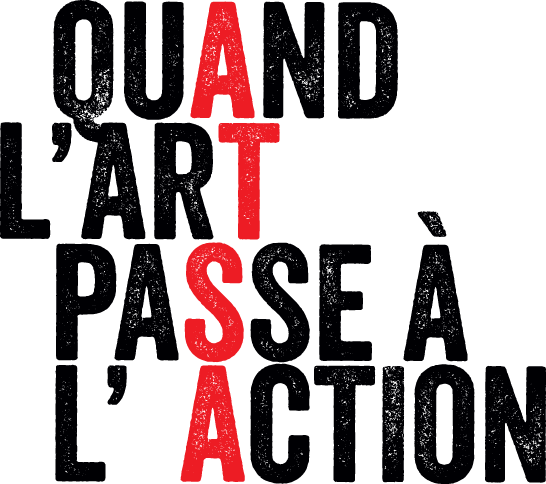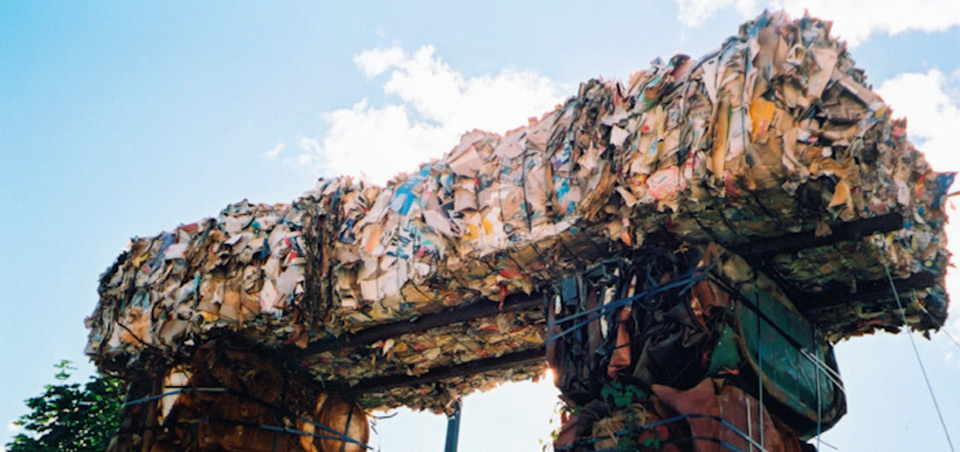ProjeCt|Program|dEtails
Parc Industriel : quand l'homme se reproduisait encore par lui-même
ATSA sets up shop at the corner of Sherbrooke and Clark streets, a stone’s throw from the patrimonial jewel that is the Notman House, and offers Parc Industriel : quand l’homme se reproduisait encore par lui-même (Industrial Park: when man still reproduced on his own). Resembling a mock archaeological tourist attraction made of waste, the park shoots us forward to the year 3541 A.D. to discover a fallen civilization that turns out to be ours. The Sherbooke St. installation, and more particularly its Great Arch made of 35 tonnes of compressed recycled scrap metal and paper, acts as a gateway to time travel. Eleven intervention islands are each accompanied by a museum-like text explaining the lifestyle of that irresponsible race of inhabitants, eloquently and incisively demonstrating the hypocrisy and myopia of our hyperconsumerist society. The artists not only give back to the site of a former Greek Orthodox church its contemplative and reflective vocation, but also—and this is quite dear to ATSA—create a setting where citizens can discover their political clout and take a position through their taking possession. The site hosts presentations by experts who tackle a range of topics, including GMOs, green transportation and the state of potable water, as well as numerous appearances by engaged artists.
The Parc Industriel project came about in response to a reflection on that which we count on leaving as a legacy for the generations to come; and implicitly, on the driving values of today’s society, whose ecological consequences are often little-known or avoided completely. The project takes the form of a visit to an archaeological site buried in the wilderness that unveils the remains of an ancient civilization – one that happens to be our own. This trip through time will transform the site into an open air forum for the exhibits and events. Its architectural structures, made from bales of metal and compressed recycled material and weighing 3 to 35 tons each, are an analogy to the ephemeral nature of our very existence. The various interventions scheduled become metaphorical witnesses to our civilization, reflecting our self-centered destructiveness.
As with other archaeological sites open to tourists, the Parc Industriel is a public space. It is also a place for amusement and reflection, a meeting place, a part of nature. Don’t miss this stimulating architectural, aesthetic, historical and temporal experience.
Parc Industriel benefits of the support of Conseil des arts du Canada, Conseil des Arts et des lettres du Québec, Ville de Montréal, Secrétariat de la jeunesse, Ministre Agnès Maltais, Jardin Botanique, l’école Louis Riel, Bon Dieu dans la rue, l’X, journal Voir/Hour, Ministère de la culture et des communication, Musée pointe à Calière et des entreprises Compo-Richelieu, Fer & Métaux recyclés, Empress and many other precious private donators.
slideshow
Photos : © Bo Huang, Martin Savoie & ATSA
the site
video
sound track
«Montréal, le Monde»
(48 min.) Réalisation: Laurent Maslé et ATSA.
thanks
Parc Industriel receives support from the Canada Council for the Arts, the Conseil des Arts et des lettres du Québec, the City of Montreal, the Secrétariat de la jeunesse, from the office of Minister Agnès Maltais, the Montréal Botanical Garden, l’école Louis Riel, le Bon Dieu dans la rue, l’X, Voir/Hour, the Ministère de la culture et des communications, the Musée at Pointe à Callière and Compo-Richelieu, Fer & Métaux recyclés, Empress and from other private donors.

![]()
![]()





















